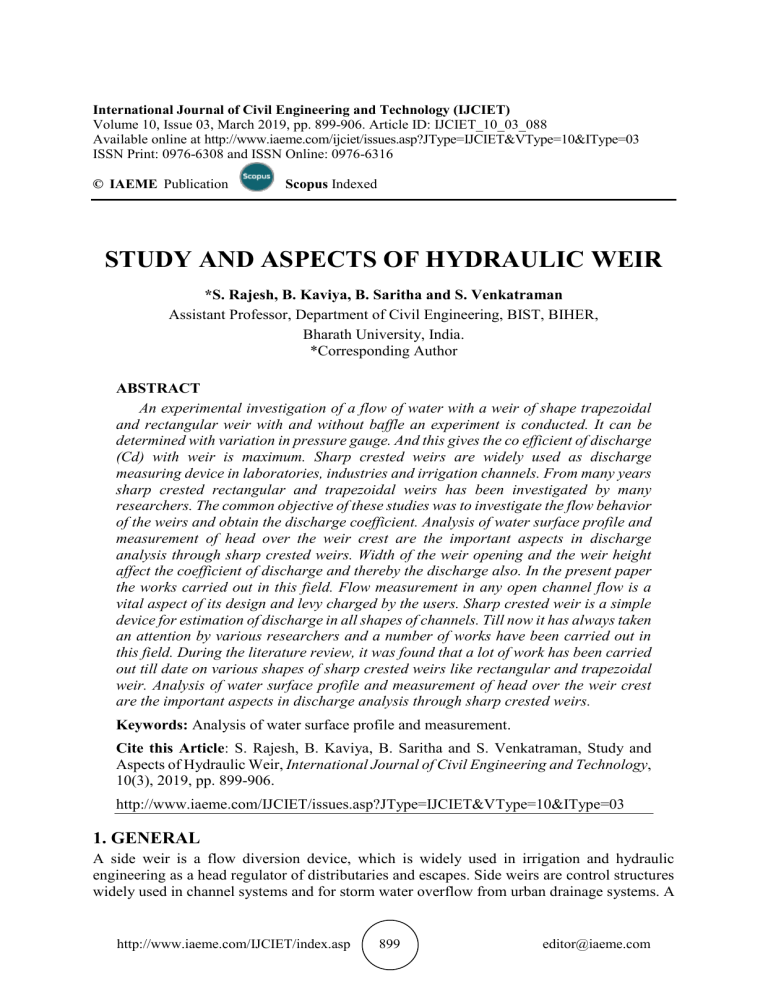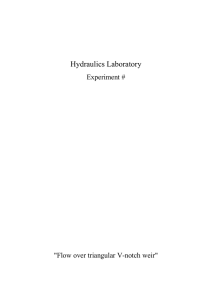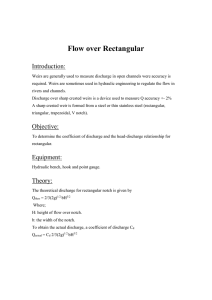
International Journal of Civil Engineering and Technology (IJCIET) Volume 10, Issue 03, March 2019, pp. 899-906. Article ID: IJCIET_10_03_088 Available online at http://www.iaeme.com/ijciet/issues.asp?JType=IJCIET&VType=10&IType=03 ISSN Print: 0976-6308 and ISSN Online: 0976-6316 © IAEME Publication Scopus Indexed STUDY AND ASPECTS OF HYDRAULIC WEIR *S. Rajesh, B. Kaviya, B. Saritha and S. Venkatraman Assistant Professor, Department of Civil Engineering, BIST, BIHER, Bharath University, India. *Corresponding Author ABSTRACT An experimental investigation of a flow of water with a weir of shape trapezoidal and rectangular weir with and without baffle an experiment is conducted. It can be determined with variation in pressure gauge. And this gives the co efficient of discharge (Cd) with weir is maximum. Sharp crested weirs are widely used as discharge measuring device in laboratories, industries and irrigation channels. From many years sharp crested rectangular and trapezoidal weirs has been investigated by many researchers. The common objective of these studies was to investigate the flow behavior of the weirs and obtain the discharge coefficient. Analysis of water surface profile and measurement of head over the weir crest are the important aspects in discharge analysis through sharp crested weirs. Width of the weir opening and the weir height affect the coefficient of discharge and thereby the discharge also. In the present paper the works carried out in this field. Flow measurement in any open channel flow is a vital aspect of its design and levy charged by the users. Sharp crested weir is a simple device for estimation of discharge in all shapes of channels. Till now it has always taken an attention by various researchers and a number of works have been carried out in this field. During the literature review, it was found that a lot of work has been carried out till date on various shapes of sharp crested weirs like rectangular and trapezoidal weir. Analysis of water surface profile and measurement of head over the weir crest are the important aspects in discharge analysis through sharp crested weirs. Keywords: Analysis of water surface profile and measurement. Cite this Article: S. Rajesh, B. Kaviya, B. Saritha and S. Venkatraman, Study and Aspects of Hydraulic Weir, International Journal of Civil Engineering and Technology, 10(3), 2019, pp. 899-906. http://www.iaeme.com/IJCIET/issues.asp?JType=IJCIET&VType=10&IType=03 1. GENERAL A side weir is a flow diversion device, which is widely used in irrigation and hydraulic engineering as a head regulator of distributaries and escapes. Side weirs are control structures widely used in channel systems and for storm water overflow from urban drainage systems. A http://www.iaeme.com/IJCIET/index.asp 899 editor@iaeme.com Study and Aspects of Hydraulic Weir side weir is designed to divert a certain amount of discharge, and therefore knowing an accurate discharge coefficient is important. Due to the use of various geometric and hydraulic shapes of the side weir, and the different channel cross sections in which the weir is placed, it is not unexpected that much research work has been conducted from different view points for different types of side weir. Like normal weirs, side weirs may be of different shapes (i.e., rectangular, triangular, trapezoidal etc.). upstream waterlevel control and discharge of excess flow Examples are check structures and cross regulators in irrigation canals, and drop structures in steep natural streams and canals (2). 2. HYDRAULIC WEIR Weir is a barrier across a river designed to alter the flow characteristics. . They are two types of weir 1. Sharp-crested weir 2. Broad-crested weir 2.1. Sharp-Crested Weir Sharp-crested weirs are typically constructed by placing a thin, rust resistant metal plate, with a notch in the top of it, perpendicular to the flow of water (concrete and timber can also be used to construct) (3). There are two main types of sharp-crested weirs: a) Rectangular—Measure Discharge and Change Water Elevations b) Trapezoidal—Measure Discharge and Change Water Elevations with Large Head. 2.2. Board-Crested Weir Typically, sturdier than sharp-crested weirs. Used in medium to large size rivers and canals (sturdier). Used as a flow measurement and water level regulator. Necessary for flow to be in subcritical range—ensures smooth water surface. 2.3. Uses of Weir Weirs are highly useful hydraulic tools that allow engineers to control water height, velocity, and most importantly they can be used to calculate discharge. Weir are commonly used to prevent flooding, measure the discharge. 2.4. Baffle Wall 1. Baffle wall is a device used to alternate flow pattern in tank 2. It is used to control velocity and prevent soil erosion 3. It is used to modify the existing portable water service in the reservoir 2.5. Objectives The main objective of the study is To determine co-efficient of discharge of weir based on shape by using gauge pressure To compare the value of co-efficient discharge for the various shape of weir by graphical method. http://www.iaeme.com/IJCIET/index.asp 900 editor@iaeme.com S. Rajesh, B. Kaviya, B. Saritha and S. Venkatraman Figure 1 Methodology Flowchart 3. PROCEDURE FOR THE SET UP 1. The inlet value is first kept closed and check whether there is a little gentle flow of water in the notch the hook gauge reading at the still of notch is found out 2. Then the motor is switched on and the inlet value is opened. Then fix the pressure gauge with different reading to control flow of water. When there is a gentle flow without any vibration the hook gauge reading at the still of the notch is found out 3. Now close the valve of collecting tank and time for 5cm rise of water is noted 4. Now vary the discharge and repeat the same ten to sixteen discharge 5. The results are tabulated. The area of collecting tank is noted 6. A graph is drawn taking along x axis as co efficient of discharge cd and y axis as pressure along y axis Figure 1 Experimental set-up http://www.iaeme.com/IJCIET/index.asp Figure 2 Rectangular notch 901 editor@iaeme.com Study and Aspects of Hydraulic Weir Figure 3. Rectangular weir with baffle Figure 4.Trapezoidal weir with baffle 3.1. Formula This equation is applicable to all head-to-height ratios and all head-to-width ratios or sharp crested and finite crested weirs (5). 3.2. Rectangular Weir Qact = AY/t m^3/s Qth = 2/3 b√2g (H) 3/2 m^3/s Cd = Qact/Qth Where, A= area of collecting tank Y = rise of water for 5 cm rise t= time taken for 5 cm rise b= breadth of weir g= specific gravity ( 9.81) h= head over the notch Qact= actual discharge Qth= theoretical discharge. 4. TRAPEZOIDAL Applying trapezoidal geometry for side weirs. The discharge coefficient needs to be found experimentally for any kinds of trapezoidal side weirs (6) Qact = Ay/t m^3/sec 𝜃 Qth=2/3 b√2g (H) 3/2 + 8/15 tan 2 √2𝑔(𝐻)5 𝑚3 sec 2( ) Cd= Qact/Qth Where, A= area of collecting tank Y = rise of water for 5 cm rise t= time taken for 5 cm rise http://www.iaeme.com/IJCIET/index.asp 902 editor@iaeme.com S. Rajesh, B. Kaviya, B. Saritha and S. Venkatraman b= breadth of weir g= specific gravity (9.81) h= head over the notch Qact= actual discharge Qth= theoretical discharge Table 1 Experimental investigation of flow of water with rectangular weir S.No. 1 2 3 4 5 6 7 8 9 10 11 12 13 14 15 16 Final hookgauge reading (H1) cm 8.5 8.5 8.5 8.5 8.5 8.5 8.5 8.5 8.5 8.5 8.5 8.5 8.5 8.5 8.5 8.5 Head over fill H=H1-H0(cm) 2.1 2.4 2.5 2.7 2.8 3 3.1 3.3 3.4 3.5 3.6 3.7 3.8 3.9 4 4.1 Time for 5cm rise (s)t 37.1 35.34 31.15 29.25 27.84 25.47 22.69 22.5 20.22 20.2 18.88 17.94 17.75 17 16.72 16.06 Qact m3/s Qth m3/s X10^-4 3.36x10^-4 3.153x10^-4 4.01x10^-4 4.27x10^-4 4.48x10^-4 4.90x10^-4 5.55x10^-4 5.56x10^-4 6.18x10^-4 6.19x10^-4 6.62x10^-4 6.96x10^-4 7.04x10^-4 7.35x10^-4 7.47x10^-4 7.78x10^-4 X10^-4 4.48x10^-4 5.48x10^-4 5.53x10^-4 6.54x10^-4 6.91x10^-4 7.67x10^-4 8.84x10^-4 8.85x10^-4 9.25x10^-4 9.67x10^-4 1.008x10^-3 1.050x10^-3 1.093x10^-3 1.137x10^-3 1.181x10^-3 1.22x10^-3 Pressure gauge Kg/cm^2 2 1.9 1.8 1.7 1.6 1.5 1.4 1.3 1.2 1.2 1 0.9 0.8 0.7 0.6 0.5 Cd No units 0.75 0.644 0.687 0.652 0.685 0.635 0.62 0.63 0.668 0.64 0.656 0.662 0.644 0.646 0.6325 0.64 Table 3.2 Rectangular weir with baffle wall S.No. 1 2 3 4 5 6 7 8 9 10 11 12 13 14 15 Final hookgauge reading (H1) cm 8.7 8.7 8.7 8.7 8.7 8.7 8.7 8.7 8.7 8.7 8.7 8.7 8.7 8.7 8.7 Head over fill H=H1-H0(cm) 4.4 4.7 5 5.2 5.3 5.5 5.7 5.9 6.4 6.7 6.8 7 7.1 7.3 7.6 Time for 5cm rise (s)t 36.84 35.91 33.5 30.09 27.47 26.41 24.91 23 20.29 19.34 18.75 18.44 17.69 17.47 16.05 http://www.iaeme.com/IJCIET/index.asp 903 Qact m3/s Qth m3/s X10^-4 3.39x10^-4 3.48x10^-4 3.73x10^-4 4.15x10^-4 4.55x10^-4 4.73x10^-4 5.02x10^-4 5.43x10^-4 6.16x10^-4 6.46x10^-4 6.67x10^-4 6.77x10^-4 7.06x10^-4 7.15x10^-4 7.77x10^-4 X10^-4 1.36x10^-3 1.50x10^-3 1.65x10^-3 1.75x10^-3 1.80x10^-3 1.90x10^-3 2x10^-3 2.12x10^-3 2.89x10^-3 2.56x10^-3 2.61x10^-3 2.73x10^-3 2.79x10^-3 2.91x10^-3 3.09x10^-3 Pressure gauge Kg/cm^2 2 1.9 1.8 1.7 1.6 1.5 1.4 1.3 1.2 1.2 1 0.9 0.8 0.7 0.6 editor@iaeme.com Cd 0.249 0.232 0.226 0.237 0.252 0.248 0.251 0.256 0.213 0.252 0.255 0.247 0.253 0.245 0.251 Study and Aspects of Hydraulic Weir Table 3.3 Trapezoidal weir without baffle wall S.No. 1 2 3 4 5 6 7 8 9 10 11 12 13 14 15 Final hook gauge reading (H1) cm 6.4 6.4 6.4 6.4 6.4 6.4 6.4 6.4 6.4 6.4 6.4 6.4 6.4 6.4 6.4 Head over fill H=H1-H0(cm) 2.4 2.5 2.7 2.8 2.9 3 3.2 3.3 3.4 3.5 3.6 3.7 3.8 3.9 4 Time for 5cm rise (s)t 36.39 35.45 33.66 31.78 27.28 27 24.66 23.31 22.21 19.75 18.81 18.1 17.32 17.15 16.29 Qact m3/s Qth m3/s X10^-4 2 1.9 1.8 1.7 1.6 1.5 1.4 1.3 1.2 1.1 1 0.9 0.8 0.7 0.6 X10^-4 3.43x10^-4 3.52x10^-4 3.71x10^-4 3.93x10^-4 4.58^10^-4 4.62x10^-4 5.06x10^-4 5.36x10^-4 5.62x10^-4 6.32x10^-4 6.64x10^-4 6.90x10^-4 7.21x10^-4 7.31x10^-4 7.61x10^-4 Pressure gauge Kg/cm^2 4.61x10^-4 4.96x10^-4 5.68x10^-4 6.06x10^-4 6.46x10^-4 6.86x10^-4 7.72x10^-4 8.16x10^-4 8.63x10^-4 9.11x10^-4 9.59x10^-4 1.009x10^-3 1.060x10^-3 1.11x10^-3 1.16x10^-3 Cd 0.74 0.7 0.65 0.64 0.71 0.67 0.65 0.66 0.65 0.69 0.7 0.68 0.68 0.65 0.66 Table 3.4 Trapezoidal weir with Baffle wall S.No. 1 2 3 4 5 6 7 8 9 10 11 12 13 14 15 Final hookgauge reading (H1)cm 6.9 6.9 6.9 6.9 6.9 0.9 6.9 6.9 6.9 6.9 6.9 6.9 6.9 6.9 6.9 Head over fill H=H1-H0(cm) 3.1 3.2 3.4 3.5 3.7 3.8 3.9 4.1 4.2 4.3 4.4 4.5 4.6 4.7 4.8 Time for 5cm rise (s)t 2 1.9 1.8 1.7 1.6 1.5 1.4 1.3 1.2 1.1 1 0.9 0.8 0.7 0.6 Qact m3/s Qth m3/s X10^-4 28.56 27.34 24.74 23.03 21.93 20.25 19.06 17.25 16.22 15.94 14.25 13.94 13.63 13.38 12.94 X10^-4 4.37x10^-4 4.57x10^-4 5.05x10^-4 5.92x10^-4 5.69x10^-4 6.17x10^-4 6.55x10^-4 7.25x10^-4 7.70x10^-4 7.84x10^-4 8.77x10^-4 8.96x10^-4 9.17x10^-4 9.34x10^-4 9.65x10^-4 Pressure gauge Kg/cm^2 7.72x10^-4 7.72x10^-4 8.63x10^-4 9.11x10^-4 1.009x10^-4 1.060x10^-4 1.11x10^-3 1.22x10^-3 1.27x10^-3 1.34x10^-3 1.39x10^-3 1.45x10^-3 1.52x10^-3 1.58x10^-3 1.64x10^-3 Cd 0.566 0.59 0.585 0.594 0.563 0.582 0.59 0.594 0.606 0.585 0.63 0.617 0.603 0.591 0.588 5. RESULTS AND DISCUSSION The results of the experimental work have been shown below.In this study the head of water over the crest are determined for maximum flow to minimum flow. The discharge co-efficient of weirs depends on shape,angle and contraction of the surface. From the graphs it is clear that the cd value decreases if we use baffles since the head of water over the crest increases. The reason is that if the head of water over the crest increases the flow is said to thicken and fills out the weir section. The discharge is not linearly increase with head measurement. The cd value for rectangular weir is 0.65 and with baffle is 0.244, similarly for trapezoidal weir is 0.67 and with baffle is 0.59.It is clear that cd for flat weir is high when compared to weir with baffle. http://www.iaeme.com/IJCIET/index.asp 904 editor@iaeme.com S. Rajesh, B. Kaviya, B. Saritha and S. Venkatraman The results show that the frequency of the clamped boundary is minimum; the influences of baffle length-width ratio and relative height on the basic frequency are much greater than that of the other system parameters; the relation between baffle length-width ratio and the frequency is exponential, while baffle relative height has a parabola relation with the frequency; the larger the baffle length-width ratio, the closer the baffle to the liquid level; the coupling frequency will be reduced more obviously(4) 5.1. Rectangular without Baffle Wall Cd FOR RECTANGULAR WEIR WITHOUT BAFFLE WALL 0.8 Cd 0.6 0.4 0.2 0 2.1 2.4 2.5 2.7 2.8 3 3.1 3.3 3.4 3.5 3.6 3.7 3.8 3.9 4 4.1 H Figure 1 Cd for rectangular weir without baffle wall 5.2. Rectangular with Baffle Wall Cd FOR RECTANGULAR WEIR WITH BAFFLE WALL Cd 0.3 0.2 0.1 0 4.4 4.7 5 5.2 5.3 5.5 5.7 5.9 6.4 6.7 6.8 7 7.1 7.3 7.6 7.8 H Figure 2 Cd for rectangular weir with baffle wall 5.3. Trapezoidal Without Baffle Wall Cd Cd FOR TRAPEZOIDAL WEIR WITHOUT BAFFLE WALL 0.75 0.7 0.65 0.6 0.55 2.4 2.5 2.7 2.8 2.9 3 3.2 3.3 3.4 3.5 3.6 3.7 3.8 3.9 4 4.1 H Figure 3 Cd for trapezoidal without baffle wall http://www.iaeme.com/IJCIET/index.asp 905 editor@iaeme.com Study and Aspects of Hydraulic Weir 5.4. Trapezoidal with Baffle Wall Cd Cd FOR TRAPEZOIDAL WEIR WITH BAFFLE WALL 0.64 0.62 0.6 0.58 0.56 0.54 0.52 3.1 3.2 3.4 3.5 3.7 3.8 3.9 4.1 4.2 4.3 4.4 4.5 4.6 4.7 4.8 4.9 H Figure 4Cd for trapezoidal weir with baffle wall 6. CONCLUSION The results obtained show the effect of weir on discharge. The main objective of the study is to compare the discharge coefficient of weir with and without baffles. From the results it is clear that the cd value is high for weir without baffles. The use of baffles retards the flow velocity and also reduces the discharge.The size of weir openings and different angle of weir are important factor to be considered.It can be concluded that trapezoidal weir without baffle is more efficient since it gives higher cd and it can be used for irrigation purposes. REFERENCES [1] [2] [3] [4] [5] [6] Rahul Pandey, Dr.S.K .Mittal and prof M.K.Choundhary, Flow Characteristics of Sharp Crested Rectangular Weir: A Review (March 2016 Vol. 3 Issue 3) W. Boiten Flow measuring structures (November 1993) Dr.Pierre JulianErik Sutherland Trevor Taylor (nov 2014) Wei Jing,1 Xuansheng Cheng,1,2 Wei Shi,1 Jin Fan,1 and Huan Feng1 Study of Baffle Boundary and System Parameters on Liquid-Solid Coupling Vibration of Rectangular Liquid-Storage Structure (February 2016). Pabhata k.swamee Generalized Rectangular Weir Equations (August 1988) Farzaneh Nezami, Mohammad Ali Nekooie, Davood Farsadizadeh Discharge coefficient for trapezoidal side weir (June 2015) http://www.iaeme.com/IJCIET/index.asp 906 editor@iaeme.com


